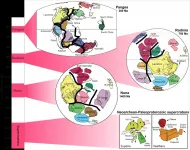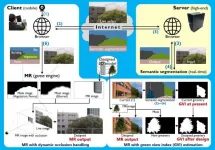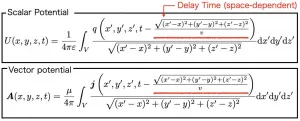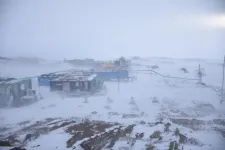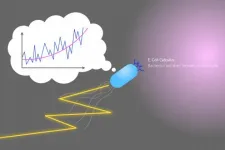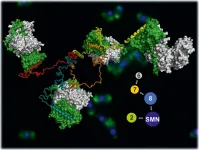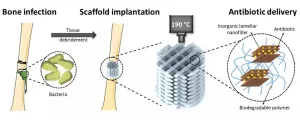(Press-News.org) Curtin University research has uncovered the first solid clues about the very beginning of the supercontinent cycle of Earth, finding it was kick-started two billion years ago.
Detailed in a paper published in Geology, a team of researchers from Curtin's Earth Dynamics Research Group found that plate tectonics operated differently before two billion years ago, and the 600 million years supercontinent cycle likely only started during the second half of Earth's life.
Lead researcher Dr Yebo Liu from Curtin's School of Earth and Planetary Sciences said that the shift in plate tectonics marked a regime change in the Earth System.
"This regime change impacted on the eventual emergence of complex life and even how Earth resources are formed and preserved," Dr Liu said.
"Pangea was the first supercontinent scientists discovered early last century that existed some 300 million years ago and lasted until the age of the dinosaurs. Geologists realised more recently that at least two older supercontinents existed before Pangea in the past two billion years (Ga) in a 600 million year cycle. But what happened in the first 2.5 billion years of Earth's history is anybody's guess."
"Our research was essentially testing two hypotheses - one is that the supercontinent cycle started prior to two billion years ago. Alternatively, the ancient continents (called cratons) only managed to get together in multiple clusters called supercratons, instead of forming a singular supercontinent."
To conduct their tests, the Curtin researchers ventured into the hills east of Perth, Western Australia, an area known as the Yilgarn craton.
Dr Liu said Yilgarn was a critical piece of the puzzle not only because it is old, but also because there are a series of dark rocks or dolerite dykes that recorded Earth's ancient magnetic field at the time that the rocks formed.
"By precisely dating the rocks and measuring the samples' magnetic record, using a technique called palaeomagnetism, we are able to reconstruct where those rocks were (relative to the magnetic North pole) when they formed," Dr Liu said.
Co-author John Curtin Distinguished Professor Zheng-Xiang Li, from Curtin's School of Earth and Planetary Sciences, said by analysing their new data from Yilgarn, and comparing it with data available globally for other cratons, one thing became clear.
"It was clear that we can almost rule out the existence of a long-lived single supercontinent before two billion years ago (2 Ga), although transient supercontinents may have existed" Professor Li said.
"More likely, there could have been two long-lived clusters of cratons, or supercratons, before 2 Ga that were geographically isolated from each other, never forming a singular supercontinent."
Professor Ross Mitchell of the Chinese Academy of Sciences, who was previously a member of Curtin's Earth Dynamics Research Group, said the research goes some way to solving a long-standing mystery.
"The idea of an even older supercontinent has been speculated about for years. But while it has been difficult to prove, it has also been difficult to disprove," Professor Mitchell said.
Dr Liu said more studies now need to be done.
"This study surely isn't the final word on the debate, but it's certainly a step in the right direction and we need to collect data from a lot more similar rocks to further test the hypotheses," Dr Liu said.
INFORMATION:
The full paper "Archean geodynamics: Ephemeral supercontinents or long-lived supercratons" is available here.
The talented athletes are there. The cheering fans are there. But the media? It's nowhere to be found.
This is the reality of women's sports, which continue to be almost entirely excluded from television news and sports highlights shows, according to a USC/Purdue University study published on March 24th in Communication & Sport.
The survey of men's and women's sports news coverage has been conducted every five years since 1989. In the latest study, researchers found that 95% of total television coverage as well as the ESPN sports highlights show SportsCenter focused on men's sports in 2019. They saw a similar lopsidedness ...
A research group at the RIKEN Center for Computational Science (R-CCS) has found that glycans--sugar molecules--play an important role in the structural changes that take place when the virus which causes COVID-19 invades human cells. Their discovery, which was based on supercomputer-based simulations, could contribute to the molecular design of drugs for the prevention and treatment of COVID-19. The research was published in the Biophysical Journal.
When SARS-CoV-2--the coronavirus that causes COVID-19--invades a human cell, a spike protein on its surface binds to an enzyme called ACE2 on the surface of the cell. The ...
Osaka, Japan - Scientists from the Division of Sustainable Energy and Environmental Engineering at Osaka University employed deep learning artificial intelligence to improve mobile mixed reality generation. They found that occluding objects recognized by the algorithm could be dynamically removed using a video game engine. This work may lead to a revolution in green architecture and city revitalization.
Mixed reality (MR) is a type of visual augmentation in which real-time images of existing objects or landscapes can be digitally altered. As anyone who has played Pokémon Go! or similar games knows, looking at a smartphone ...
Osaka, Japan - Most of the devices used in our daily lives are operated and controlled by electricity. From the standpoint of safety and the tight supply and demand of electricity, circuit design that satisfies low electromagnetic noise and power saving is becoming increasingly important.
In an electric circuit, electric signals transmit inside the conductor, and electromagnetic fields radiate outside the conductor. Furthermore, the electromagnetic field propagates through the air and is converted into signals for itself and other circuits, which leads to electromagnetic noise. Now, a research team at Osaka University has formulated a numerical method ...
At the bottom of the world, there's a small island about four kilometers off the coast of Antarctica. In summer, temperatures climb to freezing with uninterrupted daylight for two months. In winter, they fall to minus 40 degrees Celsius without a single sunrise for two months. It is isolated and desolate, uninhabitable to all humans -- except for the Japanese Antarctic Research Expedition (JARE). Almost every year since 1956, a JARE team winters over on the island, staying in Syowa Station, from February to January to conduct various research projects. From 2004 to 2014, however, they were also research subjects themselves.
As part of a joint project between the National Institute of Polar Research at the Research Organization of Information and Systems ...
Materials science likes to take nature and the special properties of living beings that could potentially be transferred to materials as a model. A research team led by chemist Professor Andreas Walther of Johannes Gutenberg University Mainz (JGU) has succeeded in endowing materials with a bioinspired property: Wafer-thin stiff nanopaper instantly becomes soft and elastic at the push of a button. "We have equipped the material with a mechanism so that the strength and stiffness can be modulated via an electrical switch," explained Walther. As soon as an electric current is applied, the nanopaper becomes soft; when the current flow stops, it regains its strength. From an application perspective, this switchability could be interesting for damping ...
Tokyo, Japan - Scientists from the Graduate School of Information Science and Technology at The University of Tokyo calculated the efficiency of the sensory network that bacteria use to move towards food and found it to be optimal from an information theory standpoint. This work may lead to a better understanding of bacterial behavior and their sensory networks.
Despite being single-celled organisms, bacteria such as E. Coli can perform some impressive feats of sensing and adaptation in constantly changing environmental conditions. For example, these bacteria can sense the presence of a chemical ...
Imbued with special electric, mechanical and other physical properties due to their tiny size, nanofibers are considered leading-edge technology in biomedical engineering, clean energy and water quality control, among others. Now, researchers in Italy and UK have developed an automatic process to assess nanofiber fabrication quality, producing 30% more accurate results than currently used techniques.
Details were published on January 2021 in IEEE/CAA Journal of Automatica Sinica, a joint publication of the IEEE and the Chinese Association of Automation.
"In recent years, nanostructured materials have gained continuously growing interest both in scientific and industrial contexts, because of their research appeal and versatile applications," ...
SMN or in full Survival Motor Neuron: Professor Utz Fischer has been analyzing this protein and the large molecular complex of the same name, of which SMN is one of the building blocks, for many years. He holds the Chair of the Department of Biochemistry at the Julius-Maximilian's University of Würzburg (JMU), and he first discovered the molecule during his search for the root cause of spinal muscular atrophy. As scientists found out a few years ago, this disease is caused by a lack of the SNM complex.
The work group around Prof. Fischer has now succeeded in presenting a first three-dimensional model of the ...
In a ground-breaking first, researchers have fabricated 3D scaffold implants containing antibiotics at high temperatures. These scaffolds not only support bone regeneration but manage the bone infections that can arise as a result of injury or surgery.
Each year, around 4 million people worldwide develop bone infection following an open fracture or surgery. The gold standard treatment consists of a lengthy antibiotic therapy, usually delivered orally or Intravenously, and the removal of infected bone tissue, which often leaves behind a hole too large for the body to fill via normal bone regeneration. In a study published in the KeAi journal Bioactive Materials, a group of researchers from the Netherlands, Italy and Spain, outline a new treatment ...
